In the fitness community, there’s a lot of debate about the optimal approach to training when you’re in an energy deficit. Some people argue that you should focus on maintaining training loads while potentially dialing back training volume, while others contend that you should focus on keeping training volume high, even if exercise loading needs to be reduced. Both “sides” of this debate have logical arguments to support their position, but they also lack direct human research to back up their suppositions. As surprising as it may seem, until very recently, there simply weren’t any longitudinal studies testing the effects of different resistance training protocols on changes in body composition during an energy deficit (that I’m aware of, at least). However, a new study by Carlson and colleagues (1) finally provides us with a bit of data that’s relevant to this debate. Unfortunately, I don’t think it brings us any closer to a definitive answer about ideal training practices in a deficit.
The study by Carlson and colleagues is a large (130 subjects) trial, employing a randomized crossover design. Middle-aged subjects with at least six months of training experience completed the study. You can see more information about the participants in Table 1.

The study employed a four-week period of heavier (~80% of 1RM; <10 reps per set) resistance training and a four-week period of lighter resistance training (~60% of 1RM; <20 reps per set) resistance training, with an eight-week washout period between the intervention periods. The order of heavier training and lighter training was randomly assigned for each subject. The periods of heavier and lighter resistance training were identical, beyond the training loads employed. Subjects performed the same exercises, for a single set of each exercise, with each set taken slightly past momentary concentric failure (subjects performed two forced reps at the end of each set). When subjects completed more than 10 reps in a set when training with heavier loads, or more than 20 reps in a set when training with lighter loads, training loads would be increased by 5%. During the washout period, subjects returned to their customary resistance training program – all subjects were recruited from the same gym chain, which employs supervised, fairly standardized training programs for all of its members. The training employed during the washout period was similar to the training performed during the two experimental training periods (the 4 week periods of heavier and lighter training), except that subjects trained with loads of approximately 70% of 1RM. During the experimental training periods, subjects’ daily energy expenditure was estimated using standard equations that consider body composition and activity levels, and subjects were instructed to consume 20% fewer calories than their estimated maintenance needs, while aiming for 1.5 grams of protein per kilo of body mass. Subjects logged their meals in MyFitnessPal, and trainers were available to answer questions subjects might have about how to comply with their nutritional targets. At the start of the study, and following each training phase, body composition was assessed via BodPod, and leg press, chest press, and pulldown 1RM strength were estimated from 7-10RM tests using the Epley equation [1RM = weight lifted × (1 + (0.033 × number of reps performed))]. The study design is illustrated in Figure 1.

Overall, both approaches to training produced nearly identical results. Subjects didn’t lose a ton of fat or gain a ton of lean mass in either condition, as you should expect, since each training period was just four weeks. If you wanted to squint really hard, it might appear that heavier training was slightly better for fat loss (-0.67kg of fat mass, versus -0.55kg of fat mass following lighter training), while lighter training was slightly better for gaining/retaining lean mass (+0.22kg of lean mass, versus +0.06kg of lean mass following heavier training), but between-group differences were absolutely tiny in practical terms (I don’t think anyone’s going to get worked up about a difference of 0.12kg of fat mass, or 0.16kg of lean mass, especially when assessed via BodPod), and were nowhere close to statistical significance. Gains in strength were also similar between groups. Furthermore, there were virtually no changes in strength or body composition during the eight-week washout period. You can see these results in Tables 2 and 3, and Figures 2-4.
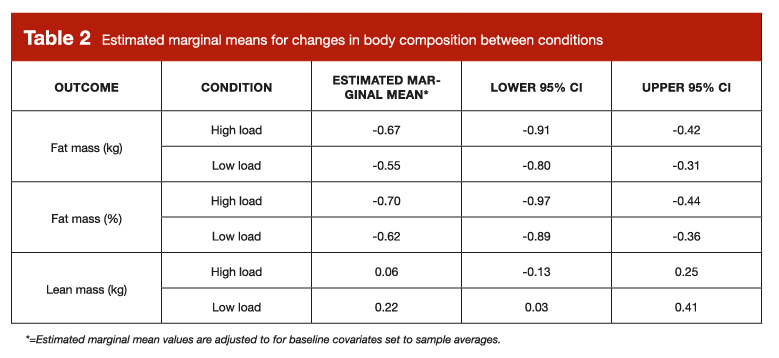
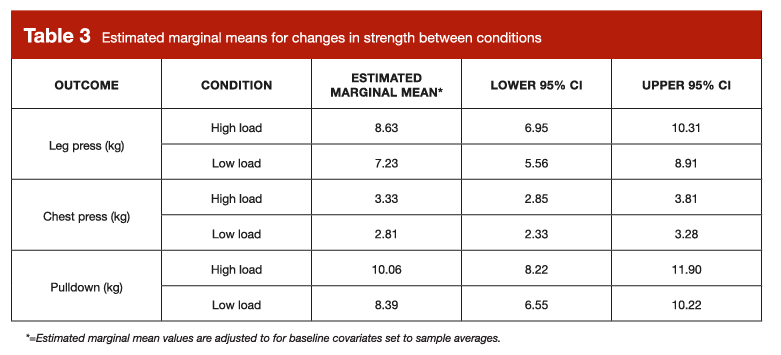
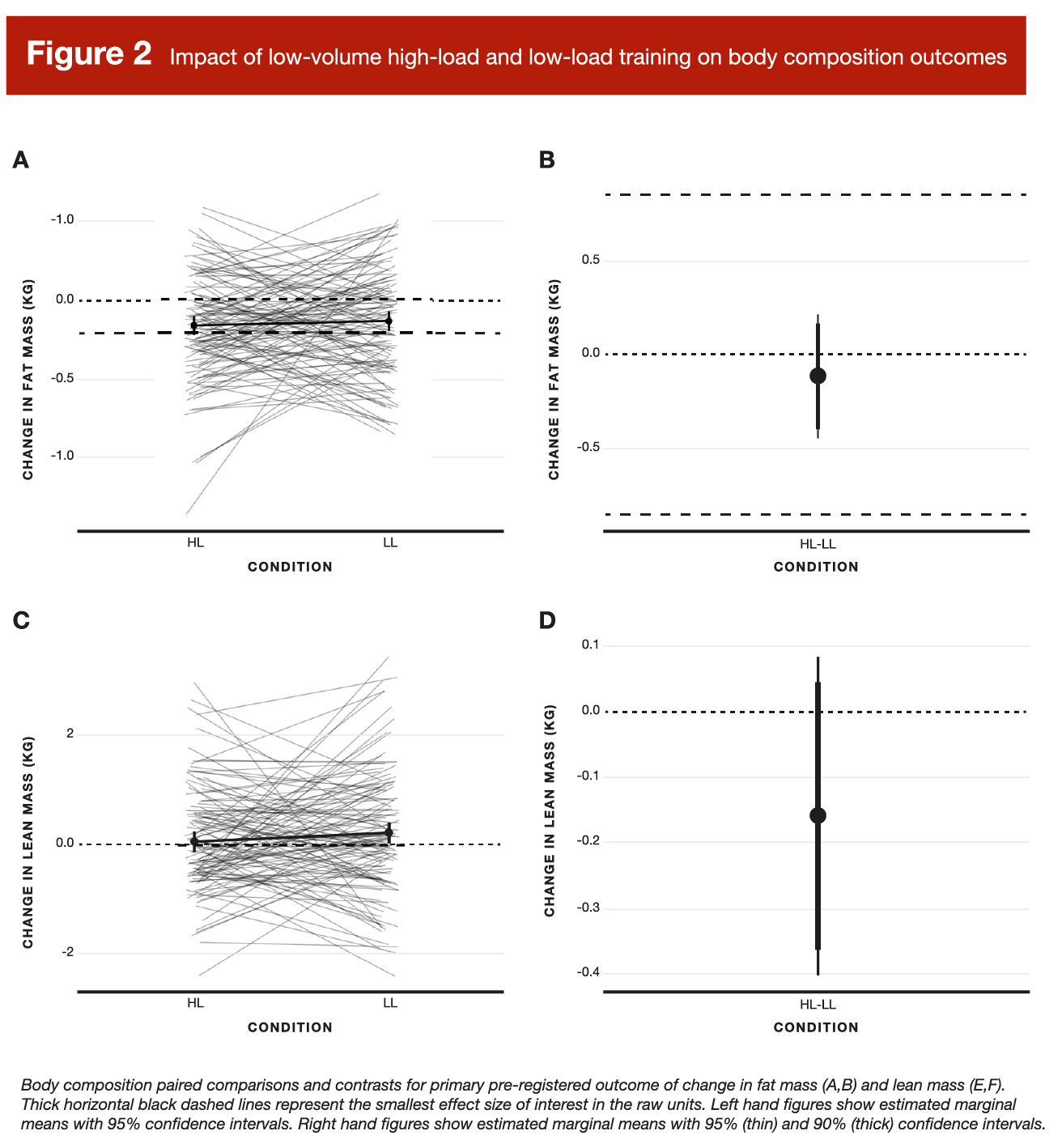
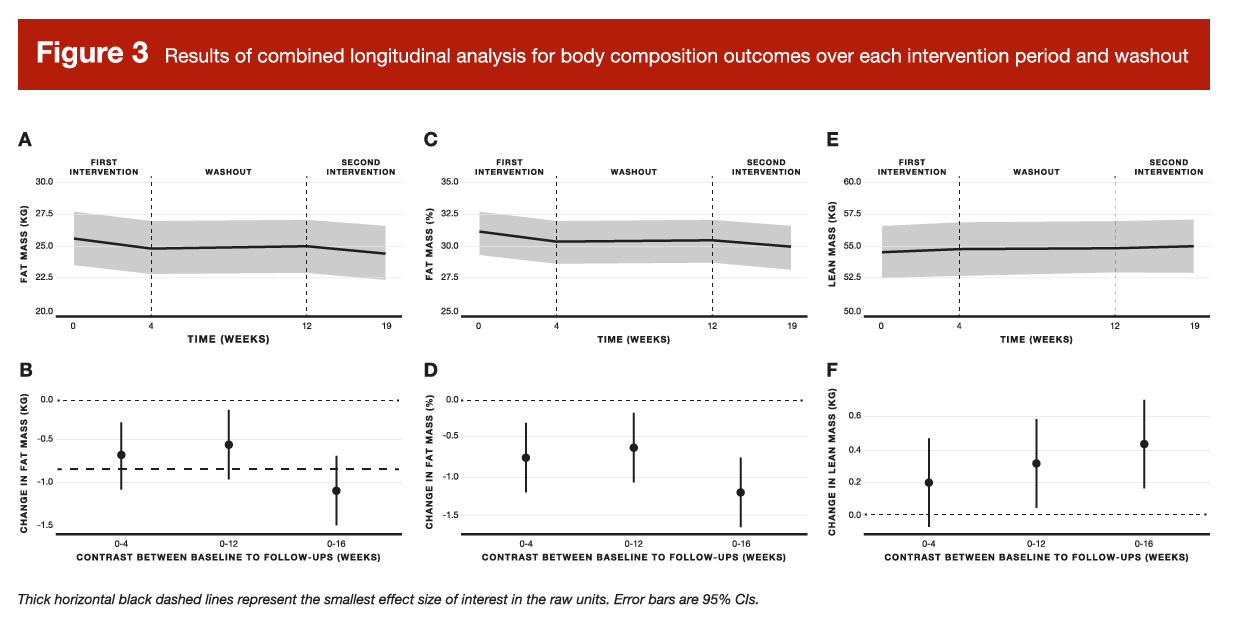
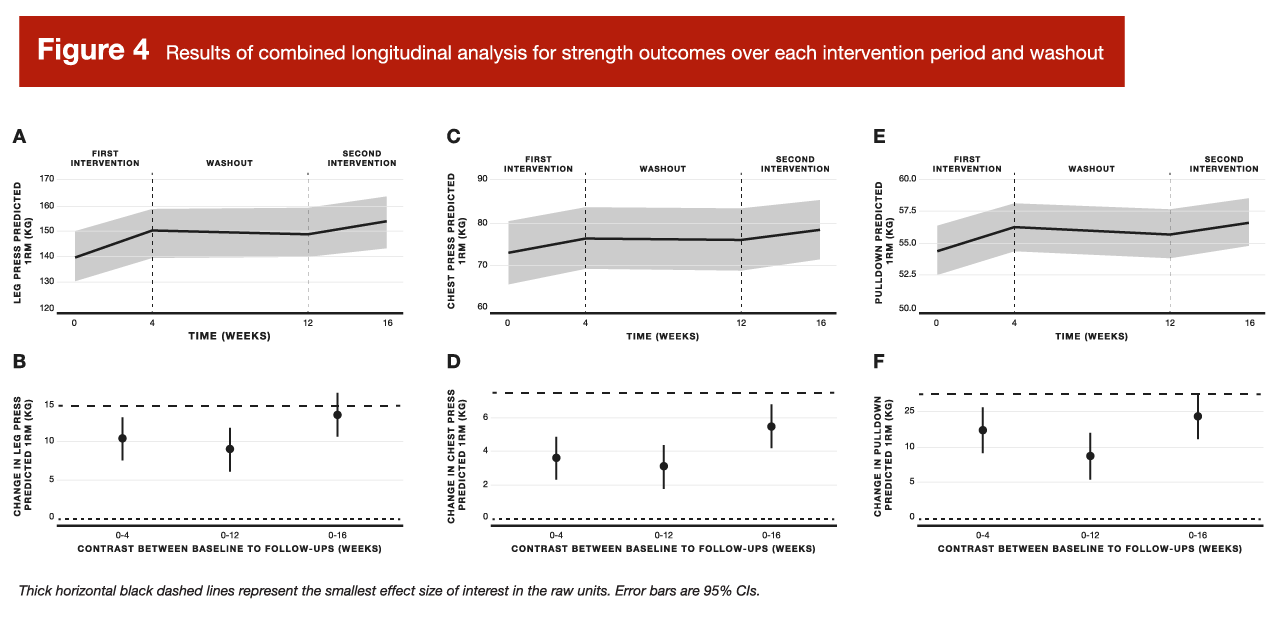
Overall, I thought this was a very well-done study (1). I suspect that some readers will be disappointed that it didn’t have any big, flashy findings, suggesting that one style of training was vastly superior. However, null results are just as valuable as statistically significant results showing large differences. If two approaches to training produce different results, we want to know, so we can recommend the generally superior approach. Conversely, if two approaches to training produce similar results, we also want to know, so we don’t limit our options when making training decisions.
It’s worth noting that the present study illustrates one of the barriers to research with an intentional component of weight gain or weight loss: it’s really hard to put subjects in a controlled energy deficit or surplus of a predictable magnitude. In a vacuum, you would have expected subjects to lose about 1.5-2kg of fat during each intervention period – humans burn around 2500kcal per day, on average, so a 20% reduction should work out to an energy deficit of ~500kcal/day, which should result in about 0.4-0.5kg of fat loss per week. However, equations used to estimate daily energy expenditure have considerable capacity for estimation error (2), human subjects rarely perfectly adhere to dietary targets, and metabolic adaptation implies that reducing energy intake by 500kcal/day isn’t necessarily equivalent to generating an energy deficit of 500kcal/day (since changes in the thermic effect of feeding, spontaneous activity levels, and basal metabolism can reduce energy expenditure when you enter an energy deficit). As a result, the average reductions in fat mass were very modest, and some subjects even gained weight.
You might be inclined to fault the researchers for insufficient dietary control, but I’d caution against that. If you want to perfectly control subjects’ diets, that necessarily involves designing a study that would be prohibitively expensive – you’d need subjects to live in a metabolic ward (to ensure they weren’t eating outside food), and all meals for all subjects would need to be prepared by research assistants over a period of months. Unless governments decide that optimizing resistance training in an energy deficit is of critical importance to public health, there’s simply never going to be enough funding to see a study like that completed (with a decent sample size in a young and otherwise healthy population, at least).
Furthermore, enhanced control also involves a decrease in ecological validity. When fitness professionals give people advice, they’re giving advice to autonomous human beings who will make decisions for themselves, and who won’t robotically adhere to every detail of their training and nutrition plan. In other words, when you give people advice about how to train in an energy deficit, the people who listen to you will behave similarly to the subjects in this study – in aggregate, their behaviors will likely be directionally consistent with your advice, but they also won’t perfectly adhere to all of your recommendations. In other words, the effect of a particular set of behaviors isn’t necessarily identical to the effect of advising people to engage in a particular set of behaviors. So, this study doesn’t necessarily tell us “here are the results of these two styles of training when subjects are in exactly a 20% energy deficit,” but it does tell us, “here are the results of these two styles of training when subjects are instructed to achieve a 20% energy deficit.” Being able to make the first type of statement is very useful when you’re attempting to calculate super precise effect estimates and delineate mechanisms, but the second type of statement is far more informative about the “real world” results of training and dietary recommendations.
While the present study suggests that heavier and lighter training are similarly efficacious in an energy deficit, I don’t expect this study to dampen the debate around the topic. Proponents of lighter training in an energy deficit contend that reductions in muscle mass are downstream of reductions in volume load that occur as a diet progresses (5). Proponents of heavier training suggest that training heavy will help you better-maintain strength levels during a diet, thus allowing you to continue exposing the muscles to higher absolute levels of mechanical tension, resulting in smaller losses in muscle mass. Ultimately, the subjects in the present study didn’t lose a ton of fat, and they slightly increased both lean mass and strength performance. So, I suspect that proponents of heavier and lighter training will simply argue that the nutritional intervention in the present study wasn’t intense enough or long enough for their preferred style of training to “win out.” However, I will note that the present study does provide a bit of evidence against one of the purported benefits of lighter training in an energy deficit. With lighter training, you’re performing more mechanical work per set, so the energy cost of training should be a bit higher. Thus, the thinking goes, lighter training will burn more calories, resulting in a larger energy deficit and greater fat loss. In a vacuum, that’s probably true, but remember that advice isn’t always perfectly adhered to. When people burn more calories via exercise, they tend to consume a few extra calories and experience a reduction in other components of energy expenditure to partially compensate for the additional exercise energy expenditure. So, while energy expenditure should theoretically be a bit higher with lighter training, that doesn’t necessarily mean that lighter training will spontaneously generate a larger energy deficit than heavier training.
When reading the present study, I was struck by the fact that gains in strength and losses in fat mass were at least nominally larger during both four-week intervention periods than the eight-week washout period, and gains in lean mass were similar during the intervention periods and washout period (meaning per-week gains in lean mass were larger during the intervention periods). Subjects weren’t aiming to be in an energy deficit during the eight-week control period, and body composition changes over time bear that out (Figure 3). Furthermore, the training protocol during the washout period was very similar to the training protocols during the washout period. So, all else being equal, you should anticipate that gains in strength and lean mass should have been larger during the washout period than the intervention periods; instead, gains were nominally larger during the intervention period than the washout periods. What could explain those results?
One possibility is that subjects engaged in some unquantified behavior modifications during the intervention periods, because they knew they were being studied. Of course, they were also being studied during the washout period, but I can certainly imagine that the subjects may have thought that the intervention periods simply mattered more, and acted accordingly. In other words, there may have been a Hawthorne effect in play. Another possibility is that novelty per se may have contributed to the results. During the washout period, subjects trained with loads equal to ~70% of 1RM, which shouldn’t produce results that are meaningfully worse than training at 60% or 80% of 1RM. However, before the study, subjects had already been training at 70% of 1RM for a number of months or years, following the standardized program of the gym chain. It may be that the subjects had almost fully habituated to training at one particular intensity, such that slightly changing the training stimulus was sufficient to cause further gains in strength and lean mass. Ultimately, I don’t think there’s a single, tidy explanation for these findings, but they tickled my brain enough to warrant a mention in this research brief.
To wrap things up, let’s bring this article full circle. I framed this article by mentioning that there’s a healthy, ongoing discussion about the style of training that works best in an energy deficit. This study certainly won’t end that discussion (we need follow-up research using different populations, longer or larger energy deficits, higher-volume training protocols, etc.), but I think the individual subject data in the present study may be instructive. Referring back to Figure 2, you can see the individual changes in body composition for each subject, as a result of both training protocols. Some subjects simply did much better with heavier training, and some subjects simply did much better with lighter training. Now, some of those intra-individual differences are probably at least partially attributable to measurement error and random noise, but that cuts both ways (i.e. some of the intra-individual differences would have been smaller than the data suggests as-reported, but some would have also been even larger than the data suggests as-reported). I wouldn’t be surprised if folks have observed that they do better when training with either higher or lower loads in a deficit, assumed their experience was the universal experience, and then cobbled together some plausible-sounding explanations to explain their personal anecdote. We should also remember that “no difference on average” isn’t necessarily the same as “no difference for individuals.” I don’t think training intensity (i.e. the rep ranges you train in and the percentage of 1RM you use) has much of an effect on body composition outcomes in an energy deficit since it doesn’t have much of an effect on hypertrophy outcomes when trainees aren’t in a purposeful energy deficit (3), on average. However, we also know that training intensity can have a large impact on the amount of hypertrophy an individual experiences (4), and I suspect that also applies to folks who are aiming to preserve lean mass while losing fat in a calorie deficit. Ultimately, heavier training or lighter training may be markedly more beneficial for you in an energy deficit. For now, good old fashion trial-and-error is the only way to find out which approach will give you better results.
Note: This article was published in partnership with MASS Research Review. Full versions of Research Spotlight breakdowns are originally published in MASS Research Review. Subscribe to MASS to get a monthly publication with breakdowns of recent exercise and nutrition studies.
References
- Carlson L, Gschneidner D, Steele J, Fisher JP. The Effects of Training Load During Dietary Intervention Upon Fat Loss: A Randomized Crossover Trial. Res Q Exerc Sport. 2022 Aug 23:1-11. doi: 10.1080/02701367.2022.2097625. Epub ahead of print. PMID: 35998256.
- Amaro-Gahete FJ, Jurado-Fasoli L, De-la-O A, Gutierrez Á, Castillo MJ, Ruiz JR. Accuracy and Validity of Resting Energy Expenditure Predictive Equations in Middle-Aged Adults. Nutrients. 2018 Nov 2;10(11):1635. doi: 10.3390/nu10111635. PMID: 30400196; PMCID: PMC6266118.
- Lopez P, Radaelli R, Taaffe DR, Newton RU, Galvão DA, Trajano GS, Teodoro JL, Kraemer WJ, Häkkinen K, Pinto RS. Resistance Training Load Effects on Muscle Hypertrophy and Strength Gain: Systematic Review and Network Meta-analysis. Med Sci Sports Exerc. 2021 Jun 1;53(6):1206-1216. doi: 10.1249/MSS.0000000000002585.
- Carneiro MAS, de Oliveira Júnior GN, Sousa JFR, Martins FM, Santagnello SB, Souza MVC, Orsatti FL. Different load intensity transition schemes to avoid plateau and no-response in lean body mass gain in postmenopausal women. Sport Sci Health. 2022. https://doi.org/10.1007/s11332-022-00907-2
- Roth C, Schoenfeld BJ, Behringer M. Lean mass sparing in resistance-trained athletes during caloric restriction: the role of resistance training volume. Eur J Appl Physiol. 2022 May;122(5):1129-1151. doi: 10.1007/s00421-022-04896-5. Epub 2022 Feb 11. PMID: 35146569; PMCID: PMC9012799.




